
The Shang dynasty, also known as the Yin dynasty, was a Chinese royal dynasty that ruled in the Yellow River valley during the second millennium BC, traditionally succeeding the Xia dynasty and followed by the Western Zhou dynasty. The classic account of the Shang comes from texts such as the Book of Documents, Bamboo Annals and Records of the Grand Historian. Modern scholarship dates the dynasty between the 16th and 11th centuries BC, with more agreement surrounding the end date than beginning date.

Chinese art is visual art that originated in or is practiced in China, Greater China or by Chinese artists. Art created by Chinese residing outside of China can also be considered a part of Chinese art when it is based on or draws on Chinese culture, heritage, and history. Early "Stone Age art" dates back to 10,000 BC, mostly consisting of simple pottery and sculptures. After that period, Chinese art, like Chinese history, was typically classified by the succession of ruling dynasties of Chinese emperors, most of which lasted several hundred years. The Palace Museum in Beijing and the National Palace Museum in Taipei contains extensive collections of Chinese art.

Chinese bronze inscriptions, also commonly referred to as bronze script or bronzeware script, are writing in a variety of Chinese scripts on ritual bronzes such as zhōng bells and dǐng tripodal cauldrons from the Shang dynasty to the Zhou dynasty and even later. Early bronze inscriptions were almost always cast, while later inscriptions were often engraved after the bronze was cast. The bronze inscriptions are one of the earliest scripts in the Chinese family of scripts, preceded by the oracle bone script.

The zun or yi, used until the Northern Song (960–1126) is a type of Chinese ritual bronze or ceramic wine vessel with a round or square vase-like form, sometimes in the shape of an animal, first appearing in the Shang dynasty. Used in religious ceremonies to hold wine, the zun has a wide lip to facilitate pouring. Vessels have been found in the shape of a dragon, an ox, a goose, and more. One notable zun is the He zun from the Western Zhou.
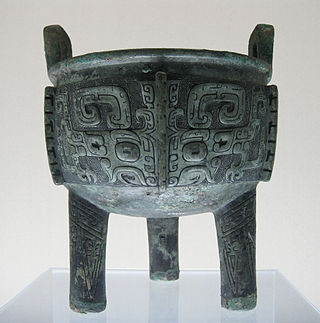
Ding are prehistoric and ancient Chinese cauldrons standing upon legs with a lid and two fancy facing handles. They are one of the most important shapes used in Chinese ritual bronzes. They were made in two shapes: round vessels with three legs and rectangular ones with four, the latter often called fāng dǐng "square ding (方鼎. They were used for cooking, storage, and ritual offerings to the gods or to ancestors.

A guang or gong is a particular shape used in Chinese art for vessels, originally made as Chinese ritual bronzes in the Shang dynasty, and sometimes later in Chinese porcelain. They are a type of ewer which was used for pouring rice wine at ritual banquets, and often deposited as grave goods in high-status burial. Examples of the shape may be described as ewers, ritual wine vessels, wine pourers and similar terms, though all of these terms are also used of a number of other shapes, especially the smaller tripod jue and the larger zun.
Dame Jessica Mary Rawson, is an English art historian, curator and sinologist. She is also an academic administrator, specialising in Chinese art.
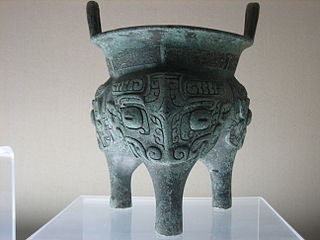
The Taotie is an ancient Chinese mythological creature that was commonly emblazoned on bronze and other artifacts during the 1st millennium BC. Taotie are one of the "four evil creatures of the world". In Chinese classical texts such as the "Classic of Mountains and Seas", the fiend is named alongside the Hundun, Qiongqi, and Taowu.

From c. 1650 BC, elaborately decorated bronze vessels were deposited as grave goods in the tombs of royalty and nobility during the Chinese Bronze Age. Documented excavations have found over 200 pieces in a single royal tomb. They were produced for an individual or social group to use in making ritual offerings of food and drink to his or their ancestors and other deities or spirits. Such ceremonies generally took place in family temples or ceremonial halls over tombs. These ceremonies can be seen as ritual banquets in which both living and dead members of a family were supposed to participate. Details of these ritual ceremonies are preserved through early literary records. On the death of the owner of a ritual bronze, it would often be placed in his tomb, so that he could continue to pay his respects in the afterlife; other examples were cast specifically as grave goods. Indeed, many surviving examples have been excavated from graves.
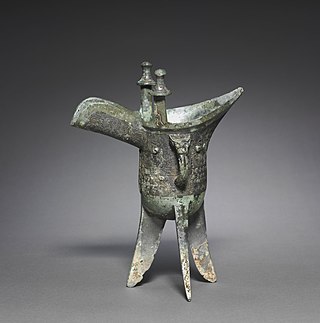
A jue is a type of ancient Chinese vessel used to serve warm wine during ancestor-worship ceremonies. It takes the form of an ovoid body supported by three splayed triangular legs, with a long curved spout on one side and a counterbalancing flange on the other. Many examples have one or two loop handles on the side and two column-shaped protuberances on the top of the vessel, which were probably used to enable the vessel to be lifted using leather straps. They are often ornately decorated with taotie decorations representing mythical beasts. They are in effect a small Chinese equivalent of the ewer. The name jue is not original, but derives from the Shuowen Jiezi, a dictionary of the 2nd century AD.

A jia is a ritual vessel type found in both pottery and bronze forms; it was used to hold libations of wine for the veneration of ancestors. It was made either with four legs or in the form of a tripod and included two pillar-like protrusions on the rim that were possibly used to suspend the vessel over heat. The earliest evidence of the Jia vessel type appears during the Neolithic Period. It was a prominent form during the Shang and early Western Zhou dynasties, but had disappeared by the mid-Western Zhou.
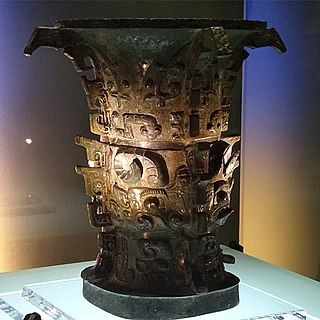
The He zun is an ancient Chinese ritual bronze vessel of the zun shape. It dates from the era of Western Zhou, specifically the early years of the dynasty, and is famous as the oldest artifact with the written characters meaning "Middle Kingdom" or "Central State" — 中國: "China" — in a bronze inscription on the container. Today it is in the Baoji Bronzeware Museum in Shaanxi.

The Tomb of Marquis Yi of Zeng is an archaeological site in Leigudun Community (擂鼓墩社區), Nanjiao Subdistrict (南郊街道), Zengdu District, Suizhou, Hubei, China, dated sometime after 433 BC. The tomb contained the remains of Marquis Yi of Zeng, and is one of a handful of ancient Chinese royal tombs to have been discovered intact and then excavated using modern archaeological methods. Zeng was a state during the Spring and Autumn period of China. The tomb was made around 433 BC, either at the end of the Spring and Autumn period or the start of the Warring States period. The tomb comes from the end of the thousand-year-long period of the burial of large sets of Chinese ritual bronzes in elite tombs, and is also unusual in containing large numbers of musical instruments, including the great set of bells for which it is most famous.

A gu is a type of ancient Chinese ritual bronze vessel from the Shang and Zhou dynasties. It was used to drink wine or to offer ritual libations.

A gui is a type of bowl-shaped ancient Chinese ritual bronze vessel used to hold offerings of food, probably mainly grain, for ancestral tombs. As with other shapes, the ritual bronzes followed early pottery versions for domestic use, and were recalled in later art in both metal, pottery, and sometimes stone. The shape changed somewhat over the centuries but constant characteristics are a circular form, with a rounded, wide, profile or shape from the side, standing on a narrower rim or foot. There are usually two, or sometimes four, handles, and there may be a cover or a square base.
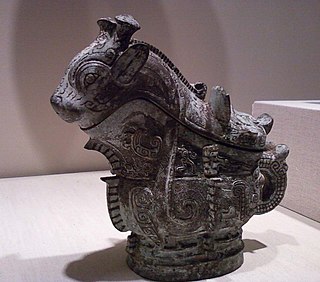
An elaborately decorated "ritual wine server" in the guang shape is a Chinese ritual bronze wine vessel, accession number 60.43, in the permanent Asian collection at the Indianapolis Museum of Art. It dates to about 1100 BCE in the Shang dynasty period. The piece is currently on display in the Arthur R. & Frances D. Baxter Gallery of the museum.

Chinese sculpture originated from the Shang, and has a history of more than 3,000 years. Chinese sculpture eventually influenced the sculpture of other nations such as Japan.
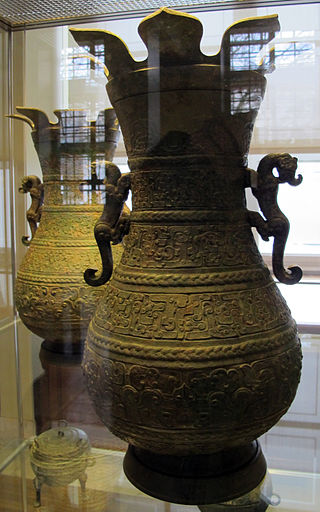
The Huixian Bronze Hu are a pair of bronze wine vessels that were found in the city of Huixian, Henan province, central China. Dating to the Eastern Zhou dynasty, they have been part of the British Museum's Asian Collections since 1972.

The Kang Hou gui is a bronze vessel that is said to have been taken from the city of Huixian, Henan province, central China. Dating to the Western Zhou period, this ancient Chinese artefact is famous for its inscription on the bottom of the interior. It has been part of the British Museum's Asian Collections since 1977.

A fangyi is a type of Chinese ritual bronze container typical of the Shang and early to middle Zhou periods of Bronze Age China. It takes the shape of a square or rectangular casket with a cover that resembles a hip roof, surmounted by a knob of a similar hipped appearance. The lower edge is typically indented with a semi-circular notch.























